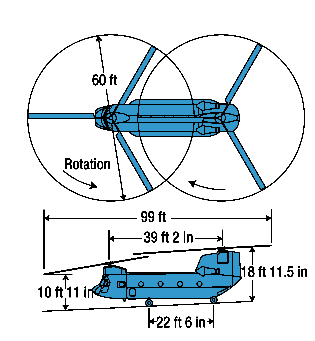
""
THE
BOEING COMPANY
|
CH-47D |


|
|
|
El Boeing CH-47 Chinook es un helicóptero de transporte pesado, biturbina y con rotores en tándem. La Boeing en Philadelphia, fabrica, moderniza y soporta al Chinook para: United States Army, Army Reserve, National Guard y operadores extranjeros. La misión
principal del Chinook en el U.S. Army es el movimiento de tropas,
artillería, munición, combustible, etc, y como segunda tarea la de
evacuación médica, recuperación de aeronaves, combate contra el
fuego, etc. En el U.S. Army National Guard y en la mayoría de los
operadores internacionales los Chinooks realizan estas últimas
misiones. Los CH-47D tienen
palas de material compuesto, sistema eléctrico e hidráulico mejorado,
triple gancho de carga, aviónica y comunicación nuevas y un motor mas
potente que puede manejar las 25000 Lbs de carga paga, cerca del doble
de la carga del Chinook original. |
|
|
|
The
Boeing CH-47 Chinook is a twin-turbine, tandem-rotor, heavy-lift
transport helicopter. Boeing in Philadelphia manufactures, modernizes
and supports the Chinook for the United States Army, Army Reserve,
National Guard and several international customers. The
Chinook's principal U.S. Army mission is movement of troops, artillery,
ammunition, fuel, water, barrier materials, supplies and equipment on
the battlefield. Secondary missions include medical evacuation, aircraft
recovery, fire fighting, parachute drops, heavy construction, civil
development, disaster relief and search and rescue. In the U.S. Army
National Guard and among international customers, Chinooks often devote
most of their flight hours on these secondary missions. The
U.S. Army has operated a variety of CH-47 Chinook models since first
taking delivery in 1962. Shortly after entering Army service, Chinooks
were deployed to Vietnam, where CH-47A, B and C models served with
distinction for a decade until the war's end in 1975. Of the nearly 750
Chinooks in the U.S. and Republic of Vietnam fleets, about 200 were lost
in combat or wartime operational accidents. After
the war, Boeing and the Army began planning a major fleet upgrade that
led to development of the CH-47D. Almost 500 early model Chinooks went
through an extensive modernization process in Philadelphia that produced
an essential new CH-47 fleet. Boeing completed first D-model deliveries
in 1982 and concluded the program in 1994. Only two U.S. Army CH-47Ds
were built to replace aircraft losses in the Persian Gulf War. All other
D models are modernized aircraft. The
CH-47D remains the U.S. Army standard and features composite rotor
blades, an improved electrical system, modularized hydraulics, triple
cargo hooks, avionics and communication improvements and more powerful
engines that can handle a 25,000-pound useful load, nearly twice the
Chinook's original lift capacity. The CH-47D Chinook already has been
the U.S. Army's prime mover for 20 years, and was a central element in
U.S. Army operations in the Persian Gulf War, where more than 160
Chinooks carried U.S. and Allied troops in history's largest aerial
assault to outflank Iraqi forces and cut off their retreat from Kuwait. U.S. Army Special Operations Forces also operate 36 Special Operations Chinooks, designated as MH-47Ds and MH-47Es. The MH-47Es are among the most advanced rotorcraft in operation today. They incorporate fully integrated digital cockpits; forward-looking infrared, terrain-following/terrain-avoidance radar; long-range fuel tanks; and aerial refueling capability. Special Operations Chinooks perform low-level, high-speed flight for infiltration and exfiltration of Special Operations teams at night and in adverse weather. Boeing and the U.S. Special Operations Command are currently discussing a Special Operations Chinook upgrade program that will provide a fleet-wide common avionics suite and several other system improvements. |
|
|
|
Characteristics |
Information |
Characteristics |
Information |
| First
Flight Primer Vuelo |
19?? | Engine Motor |
2
TEXTRON |
| Seating
Capacity Plazas |
2 / 33 |
Power Potencia |
|
| Empty
Weight Peso Vacío |
23401 Lbs |
Hover
Ceiling O.G.E. Estacionario O.G.E |
|
| Maximum
Weight Peso Máximo |
50000 Lbs |
Hover
Ceiling I.G.E. Estacionario I.G.E |
|
| Vel.
Cruise Vel. crucero |
143 Kts |
Service
Ceiling Techo de Servicio |
|
| V.N.E. V.N.E |
Kts |
Maximum
Range (Std) Alcance (Std) |
|
Copyright © 1999 / 2003